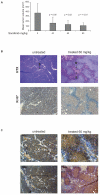Sorafenib inhibits tumor growth and vascularization of rhabdomyosarcoma cells by blocking IGF-1R-mediated signaling
- PMID: 21127754
- PMCID: PMC2994208
- DOI: 10.2147/ott.s3833
Sorafenib inhibits tumor growth and vascularization of rhabdomyosarcoma cells by blocking IGF-1R-mediated signaling
Abstract
The growth of many soft tissue sarcomas is dependent on aberrant growth factor signaling, which promotes their proliferation and motility. With this in mind, we evaluated the effect of sorafenib, a receptor tyrosine kinase inhibitor, on cell growth and apoptosis in sarcoma cell lines of various histological subtypes. We found that sorafenib effectively inhibited cell proliferation in rhabdomyosarcoma, synovial sarcoma and Ewing's sarcoma with IC(50) values <5 μM. Sorafenib effectively induced growth arrest in rhabdomyosarcoma cells, which was concurrent with inhibition of Akt and Erk signaling. Studies of ligand-induced phosphorylation of Erk and Akt in rhabdomyosarcoma cells showed that insulin-like growth factor-1 is a potent activator, which can be blocked by treatment with sorafenib. In vivo sorafenib treatment of rhabdomyosarcoma xenografts had a significant inhibitory effect on tumor growth, which was associated with inhibited vascularization and enhanced necrosis in the adjacent tumor stroma. Our results demonstrate that in vitro and in vivo growth of rhabdomyosarcoma can be suppressed by treatment with sorafenib, and suggests the possibilities of using sorafenib as a potential adjuvant therapy for the treatment of rhabdomyosarcoma.
Keywords: kinase inhibitors; soft tissue sarcoma; targeted therapy; vascularization.
Figures






References
-
- Adnane L, Trail PA, Taylor I, et al. Sorafenib (BAY 43-9006, Nexavar), a dual-action inhibitor that targets RAF/MEK/ERK pathway in tumor cells and tyrosine kinases VEGFR/PDGFR in tumor vasculature. Methods Enzymol. 2006;407:597–612. - PubMed
-
- Ammoun S, Flaiz C, Ristic N, et al. Dissecting and targeting the growth factor-dependent and growth factor-independent extracellular signal-regulated kinase pathway in human schwannoma. Cancer Res. 2008;13:5236–45. - PubMed
-
- Armistead PM, Salganick J, Roh JS, et al. Expression of receptor tyrosine kinases and apoptotic molecules in rhabdomyosarcoma: correlation with overall survival in 105 patients. Cancer. 2007;10:2293–303. - PubMed
LinkOut - more resources
Full Text Sources
Miscellaneous

